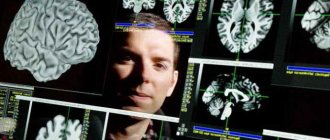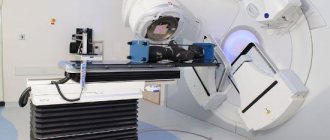Types of sensory disorders
Types of sensitivity disorders.
1. Peripheral type of disorders - impaired sensitivity in the zone of innervation of the peripheral nerve. Occurs when a peripheral nerve or plexus is damaged.
2. Segmental type of disorders - impaired sensitivity in the zone of segmental innervation. Occurs when the dorsal root of the spinal cord or spinal ganglion is damaged. For conductors of superficial sensitivity, the segmental type of disorder is also characteristic of damage to the posterior horn of the spinal cord and the anterior commissure.
3. Conductive type of disorder - impaired sensitivity throughout the entire length below the level of damage to the conductive path. Occurs when the posterior and lateral cords, brainstem, thalamus, posterior third of the posterior limb of the internal capsule, and subcortical white matter of the brain are affected.
4. Cortical type of disorders - local loss of sensitivity (usually similar to monoanesthesia, etc.) with damage to areas of the projection zone of the superficial and deep sensitivity of the cerebral cortex
5. Dissociated sensitivity disorders - loss of some types of sensitivity while maintaining others. They occur when the posterior horns of the spinal cord, the anterior gray commissure, the lateral and posterior cords of the spinal cord, the chiasm and the lower parts of the medial lemniscus, and the lateral parts of the medulla oblongata are affected.
Study of surface sensitivity.
- Pain sensitivity - the reaction to tingling with a needle in various parts of the body is assessed
- Tactile sensitivity - the reaction to light touches (with a brush or cotton wool) on various parts of the body is assessed
- Temperature sensitivity - evaluates the reaction to the touch of test tubes with cold and hot water to various parts of the body
Surface sensitivity disorders.
Anesthesia
- loss of tactile sensitivity
Analgesia
- loss of pain sensitivity
Thermal anesthesia
- loss of temperature sensitivity
Hypesthesia
- decreased tactile sensitivity
Hyperesthesia
- increased tactile sensitivity
Hyperalgesia
- excessive pain sensitivity
Painful anesthesia
- anesthesia dolorosa, in which decreased sensitivity is combined with spontaneous sensations of pain
Split pain sensation
- when pricked with a needle, the patient first feels the touch, and then the pain
Polyesthesia
- single irritation is perceived as multiple
Allocheiria
- the patient localizes the irritation not at the site of its application, but in symmetrical areas on the opposite side
Dysesthesia
- perverted perception of receptor affiliation (heat is perceived as cold, painful stimulation as warmth, etc.)
Parasthesia
- sensations of burning, tingling, crawling, constriction that occur spontaneously
Hyperpathy
- the appearance of a sharp feeling of unpleasantness when irritation is applied. It is characterized by an increase in the threshold of perception of stimuli (hypesthesia), lack of precise localization of irritation (an unpleasant sensation covers an entire area), a long latent period and a long period of aftereffect (perception lags behind the irritation in time, the unpleasant sensation persists for a long time after the cessation of the stimulus). Hyperpathia is based on a regression of sensitivity with a transition to its more primitive forms with elements of perversion of sensitivity.
Painful symptoms due to disorders of superficial sensitivity
Local pain - localized at the site of irritation
Projection pain - arising in the zone of innervation of one of the branches of the nerve trunk and projecting to the corresponding skin area
Referring pain - occurring in the zone of innervation of one of the branches of the nerve when another branch of the same nerve is irritated
Referred pain is pain that occurs due to diseases of internal organs and is localized in the Zakharyin-Ged zones.
Causalgia
- paroxysmal burning pain, localized in the area of the affected nerve, aggravated by touch or excitement. Cooling and moistening with water reduce suffering. Appears more often with traumatic injuries to nerve trunks.
Phantom pain is pain that occurs after amputation due to scar changes involving the nerve stump (analogous to projection pain), “the feeling of a non-existent limb.”
Symptoms of tension in disorders of surface sensitivity (pain symptoms that occur when the dorsal roots of the spinal cord, nerve trunks and plexuses are damaged)
Lassegue's sign
— in the supine position, when trying to bend the straightened leg at the hip joint, sharp pain occurs in the area of innervation of the sciatic nerve (phase 1 of Lassègue’s symptom), with subsequent bending of the leg at the knee joint, the pain stops (phase 2 of Lassègue’s symptom).
Neri's symptom
- when lying on your back, bending your head forward leads to pain in the lower back.
Sicard's symptom
— sharp dorsiflexion of the foot leads to pain along the sciatic nerve.
Matskevich's symptom
— in the prone position on the stomach, when bending the leg at the knee joint, painful sensations appear along the anterior surface of the thigh (in the zone of innervation of the femoral nerve)
Wasserman's sign
- in the prone position on the stomach, when raising the straightened leg upward, painful sensations occur along the anterior surface of the thigh (in the zone of innervation of the femoral nerve)
Study of deep sensitivity.
Muscular-articular feeling
- examined in a lying position with eyes closed, passive movements are made in small and large joints, the examinee must determine in which joint the movement is being made and indicate the direction of movement
Feeling pressure
— the subject indicates the location and degree of pressure on individual areas of the body.
Sense of mass
- is examined by placing objects of the same size and shape, but different masses, on the palm of your hand
Vibration sensitivity
- to study this type of deep sensitivity, a tuning fork with an oscillation frequency of 256 Hertz is used, which is applied to the surface of the body of the subject located above the bone (hands, feet, joints, etc.)
With disorders of deep sensitivity, the patient develops sensitive ataxia - loss of proprioceptive control of movements, manifested by an unsteady gait with impaired coordination of movements, sharply intensifying when closing the eyes.
Study of complex types of sensitivity.
Sense of localization - accurate recognition, with eyes closed, of the location of pinpoint skin irritation.
Discriminative sensitivity is the ability to separately perceive two identical irritations applied simultaneously to the skin.
Kinesthetic sensitivity - the ability to determine the direction of displacement of a skin fold.
Two-dimensional spatial sense - with eyes closed, the subject must identify figures drawn with a blunt object on his skin.
Stereognosis is the ability to recognize objects by touching with eyes closed.
Violation of complex types of sensitivity occurs when the projection zones of the cortex, mainly the superior parietal region, are damaged.
Dissociated type of sensitivity disorders. Brown-Séquard syndrome.
A dissociated (segmental) type of sensitivity disorder is observed with damage to the sensitive apparatus of the spinal cord (posterior horn of the spinal cord, anterior gray commissure, dorsal root) and the sensory nuclei of the cranial nerves of the brain stem, only pain and temperature sensitivity is affected, deep sensitivity is preserved
.
With damage to the posterior horn of the spinal cord
A dissociated disturbance of sensitivity occurs: in the area of the corresponding segments, superficial (pain and temperature) sensitivity disappears, but deep sensitivity remains.
In case of involvement of both dorsal horns or anterior gray commissure
a dissociated sensitivity disorder occurs on both sides (like a jacket, panties).
With damage to the dorsal root of the spinal cord
there is a loss of all sensitivity in the area of the corresponding segment.
After complete transection of the spinal cord, all types of sensitivity (pain, temperature, muscle-articular, tactile and vibration) are lost, as well as active movements distal to the site of injury
.
Brown-Séquard syndrome occurs when the spinal cord is damaged halfway (laterally)
and is manifested by the following clinical signs:
a) loss of deep and tactile sensitivity on the side of the injury distal to the site of injury;
b) loss of pain and temperature sensitivity on the opposite side distal to the site of injury;
c) the presence of spastic paralysis on the injured side.
Pain, its role in the life of the body. Causes and mechanisms of occurrence. Types of pain (visceral and somatic), their characteristics. Causalgia, phantom pain. Zakharyin-Ged zones.
A special type of sensation that often accompanies pathological processes both in the nervous system and somatic is pain.
.
Pain is a complex psycho-emotional unpleasant sensation, realized by a special system of pain sensitivity and higher parts of the brain, formed under the influence of a pathogenic stimulus, characterized by subjectively unpleasant sensations, as well as significant changes in the body, up to serious disruption of its vital functions and even death.
Pain has a signaling and pathogenic meaning.
The pain signal provides mobilization of the body to protect itself from a pathogenic agent and protectively restricts the function of the painful organ.
However, pain is often a component of the pathogenesis of various pathological processes, contributes to the severity of the disease, and may itself be the cause of the pathology.
There are several theories explaining the mechanism of pain formation.
It is assumed that there are special pain receptors (nociceptors) that are activated under the influence of specific stimuli. Extremely strong effects on sensory nerve endings from other modalities can also cause pain.
There are protopathic and epicritic pain.
Epicritic
(“quick”,
“first”
) pain occurs as a result of exposure to
small and medium-strength dragites for receptor formations of the skin and mucous membranes.
Protopathic
(“slow”, “painful”, “ancient”,
“second”
) pain occurs under the influence of strong, “destructive”, “large-scale” stimuli, its source is usually pathological processes in internal organs and tissues. This type of pain has a more diffuse, diffuse nature compared to epicritic pain.
Visceral pain plays a significant role in the symptoms of various diseases.
, i.e. localized in the internal organs. This pain is difficult to clearly localize, is diffuse in nature, accompanied by painful experiences, depression, depression, and changes in the activity of the autonomic nervous system. Visceral pain is very similar to “second” pain.
Studies conducted primarily on humans during surgery have shown that not all anatomical structures can be a source of pain. The abdominal organs are insensitive to conventional surgical influences (incision, stitching), only the mesentery and parietal peritoneum are painful. But all internal organs with unstriated muscle tissue react painfully to stretching, spasm or convulsive contraction.
Arteries are very sensitive to pain. Narrowing of the arteries or their sudden dilation causes severe pain.
Lung tissue and visceral pleura are insensitive to painful stimulation, but the parietal pleura is very sensitive in this regard.
Special types of pain syndromes include causalgia and phantom pain.
Causalgia is a paroxysmal, intensifying burning pain in the area of damaged nerve trunks (usually facial, trigeminal, sciatic, etc.). Causalgia is a severe, excruciating pain observed when any major somatic nerve is damaged. Any, even the most insignificant impact causes a sharp increase in pain.
Phantom pain is formed in the mind as a subjective pain sensation in a missing part of the body and occurs due to irritation of the central ends of nerves cut during amputation. Phantom pain occurs in people after limb amputation. For a long time, the patient may feel the amputated limb and severe, sometimes unbearable pain in it. During amputation, large nerve trunks with an abundance of thick nerve fibers are usually cut, and the channels for impulses from the periphery are interrupted. Neurons in the spinal cord become less controlled and may burst into response to unexpected stimuli.
With the development of pathological processes in some internal organs, referred pain
.
We are talking about the Zakharyin-Ged .
For example, with heart disease, pain appears in the left scapula and in the innervation zone of the ulnar nerve of the left arm; when the gallbladder is stretched, the pain is localized between the shoulder blades; When a stone passes through the ureter, pain from the lumbar region radiates to the groin area. Referred pain is explained by the fact that damage to internal organs causes excitation, which, through the afferent fibers of the autonomic nerves, reaches the same neurons of the dorsal horns of the spinal cord on which the afferent fibers from the skin end. Increased afferent impulses from internal organs lower the threshold of neuronal excitability in such a way that irritation of the corresponding skin area is perceived as pain.
Determining areas of pain in some cases can help determine damage to a particular internal organ. Determining these zones (especially in the torso area) often has diagnostic value. An increase or decrease in pain and hyperesthesia helps resolve the issue of worsening or improving the course of the disease.








